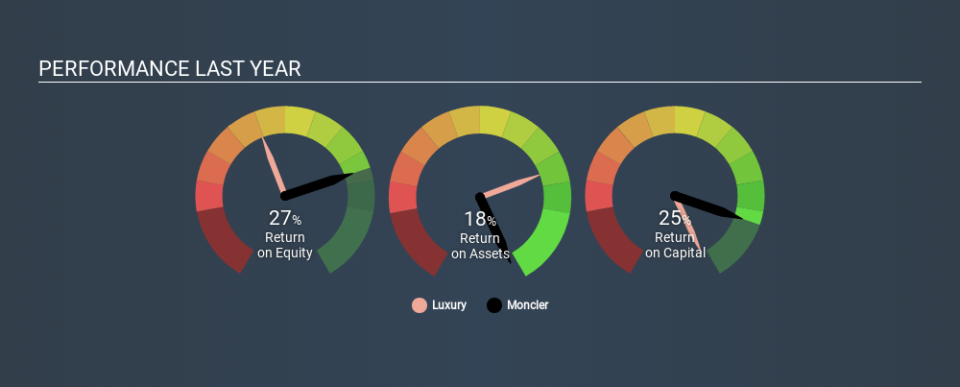Why Moncler S.p.A.’s (BIT:MONC) Return On Capital Employed Is Impressive

Today we'll look at Moncler S.p.A. (BIT:MONC) and reflect on its potential as an investment. To be precise, we'll consider its Return On Capital Employed (ROCE), as that will inform our view of the quality of the business.
First of all, we'll work out how to calculate ROCE. Then we'll compare its ROCE to similar companies. Then we'll determine how its current liabilities are affecting its ROCE.
Return On Capital Employed (ROCE): What is it?
ROCE is a measure of a company's yearly pre-tax profit (its return), relative to the capital employed in the business. All else being equal, a better business will have a higher ROCE. Overall, it is a valuable metric that has its flaws. Author Edwin Whiting says to be careful when comparing the ROCE of different businesses, since 'No two businesses are exactly alike.
So, How Do We Calculate ROCE?
The formula for calculating the return on capital employed is:
Return on Capital Employed = Earnings Before Interest and Tax (EBIT) ÷ (Total Assets - Current Liabilities)
Or for Moncler:
0.25 = €492m ÷ (€2.1b - €160m) (Based on the trailing twelve months to December 2019.)
So, Moncler has an ROCE of 25%.
View our latest analysis for Moncler
Is Moncler's ROCE Good?
ROCE is commonly used for comparing the performance of similar businesses. Moncler's ROCE appears to be substantially greater than the 11% average in the Luxury industry. I think that's good to see, since it implies the company is better than other companies at making the most of its capital. Setting aside the comparison to its industry for a moment, Moncler's ROCE in absolute terms currently looks quite high.
We can see that, Moncler currently has an ROCE of 25%, less than the 34% it reported 3 years ago. So investors might consider if it has had issues recently. The image below shows how Moncler's ROCE compares to its industry, and you can click it to see more detail on its past growth.
When considering ROCE, bear in mind that it reflects the past and does not necessarily predict the future. ROCE can be deceptive for cyclical businesses, as returns can look incredible in boom times, and terribly low in downturns. This is because ROCE only looks at one year, instead of considering returns across a whole cycle. What happens in the future is pretty important for investors, so we have prepared a free report on analyst forecasts for Moncler.
Moncler's Current Liabilities And Their Impact On Its ROCE
Short term (or current) liabilities, are things like supplier invoices, overdrafts, or tax bills that need to be paid within 12 months. Due to the way ROCE is calculated, a high level of current liabilities makes a company look as though it has less capital employed, and thus can (sometimes unfairly) boost the ROCE. To check the impact of this, we calculate if a company has high current liabilities relative to its total assets.
Moncler has total assets of €2.1b and current liabilities of €160m. Therefore its current liabilities are equivalent to approximately 7.5% of its total assets. Minimal current liabilities are not distorting Moncler's impressive ROCE.
Our Take On Moncler's ROCE
This suggests the company would be worth researching in more depth. Moncler looks strong on this analysis, but there are plenty of other companies that could be a good opportunity . Here is a free list of companies growing earnings rapidly.
For those who like to find winning investments this free list of growing companies with recent insider purchasing, could be just the ticket.
If you spot an error that warrants correction, please contact the editor at editorial-team@simplywallst.com. This article by Simply Wall St is general in nature. It does not constitute a recommendation to buy or sell any stock, and does not take account of your objectives, or your financial situation. Simply Wall St has no position in the stocks mentioned.
We aim to bring you long-term focused research analysis driven by fundamental data. Note that our analysis may not factor in the latest price-sensitive company announcements or qualitative material. Thank you for reading.

